Artemisia Gentileschi, Renaissance Painter
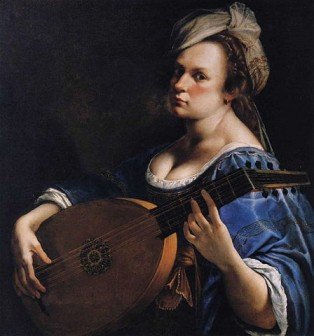
There were few women who had the chance to make their mark on the Italian art world, but Artemisia Gentileschi was definitely one of them. During her lifetime she was the first woman admitted to the Accademia delle Arti del Disegno in Florence. She painted in the courts of Europe, including that of Charles I of England, and became friends with the likes of Galileo Galilei. Nowadays her paintings are recognised as some of the finest of the period, and only last year the Museum of Connecticut paid over three million dollars for one of her self-portraits. Yet though she was lionised during her life, after her death art critics did the best they could to erase her from history. Some even insisted that her first professional paint must have been drawn by her father, despite it bearing her signature and her definite style. In their narrow view of the world, they could not see her as a painter. They could only see her as a “fallen woman”, and no more. But she was never that.
Artemisia was born in Rome in 1593. Her father was the painter Orazio Gentilischi. Like her younger brothers she grew up in his workshop, though she was the only one of his children to show any talent for the art. When she was 10 her father was briefly imprisoned as a result of his friendship with the great Caravaggio, when a rival painter charged their circle of artists with libel for creating several unflattering poems about him. Caravaggio’s style also seems to have had an impact on Artemisia. In 1605 her mother died, and she was left as the sole woman in a house full of men. Perhaps this inspired her first signed work in 1607, Susannah and the Elders. It depicts one of the most famous Biblical examples of male and female conflict, with Susannah being propositioned and then threatened by the two lecherous old men. Her work is notable in showing the trauma inherent in this event for Susannah, rather than simply using it as an excuse to show a young woman bathing as many contemporary artists did. Given how the story of Susannah turns out, with the spurned elders falsely prosecuting her as a wanton woman, her choice of material may have been either somewhat prescient, or else a way of grimly steeling herself for the ordeal she knew was to come.
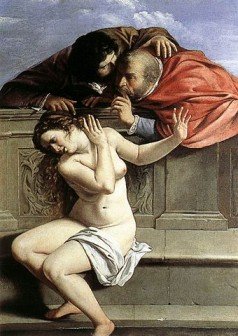
That year Orazio was working with another painter named Agostino Tassi. Seeking to broaden his daughter’s knowledge, he hired Tassi to tutor her – a decision he was to later regret. At the time Artemisia had one female friend, an older woman named Tuzia who was a tenant in the Gentilischi household. She was painting one of Tuzia’s children when Tassi came to visit. On realising her father was away, he ordered Tuzia out and then dragged Artemisia up to her bedroom and raped her. Artemisia later recounted that she did her best to fight him off, and called for help from Tuzia, but none came. After her attacker was done she took a knife from a drawer and tried to stab him, but he was easily able to fend her off. Tassi then told her that her only hope of retaining her honour was for him to marry her, then left.
Over the next nine months Tassi continued to abuse her, still claiming that he would marry her. In fact Tassi was already married, though he had previously tried to have his wife murdered (and been imprisoned for it). Finally Artemisia’s father found out. Furious, he petitioned the Pope for justice. Tassi’s trial lasted seven months, and in a development depressingly familiar to anyone who has seen coverage of similar trials nowadays, devolved into a trial of Artemisia’s character rather than of her rapist. Tassi’s evidence was defamatory and often contradictory – at one stage he claimed that Orazio had come to him concerned over the loose life his daughter led, then later claimed that Orazio was sleeping with his daughter. Artemisia’s evidence never altered, though it received a serious blow when Tuzia (probably paid off by Tassi) testified against her. Near the end of the trial Artemisia was forced to repeat her testimony before Tassi, while being tortured with thumbscrews – an action the trial transcript insists was for her benefit, to demonstrate her honesty. While the torture was going on she turned to Tassi and said “So this is the ring you give me, and these are your promises?”. Whether she was actually believed is unknown – the transcript of the trial, while extensive, is incomplete and no record of the verdict survives. If Tassi was imprisoned, he was released less than a year later.
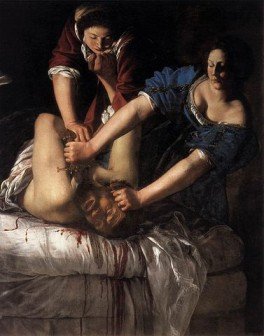
Artemisia’s primary vengeance on Tassi was an artistic one. Her most famous painting, Judith Beheading Holofernes, was painted shortly after the trial – no doubt while her thumbs were still healing from her torture. It shows Judith, with Artemisia’s face, gorily severing the head of the terrified Holofernes. Naturally, his face is that of Tassi. The painting established Artemisia’s reputation as one of the greatest painters of her generation, and not only did she create a companion piece showing the two women transporting the head, but eight years later she was commissioned to create a new version for Cosimo de Medici, the Grand Duke of Tuscany. He hid it from public view as being too graphic for general consumption. Little of Tassi’s work survives, and so his most famous role in art history is as the victim of Judith’s vengeful blade – a fitting fate
Hoping to salvage his daughter’s reputation, her father arranged a marriage for her to Pierantonio Stiattesi, a distant relative of his. This got her out of Rome and to Florence, where he lived. Here she became famous as a painter, the first woman accepted into the Accademia delle Arti del Disegno which had been founded fifty years earlier and continues to this day. There she studied alongside Galileo Galilei, and the two struck a friendship that would continue through correspondence for years. She received several commissions from the Medici family, among others, and enjoyed great success. Her husband, who was also an artist, enjoyed less success. Though they had several daughters, [1] their marriage was not ideal – he spent her money as fast as she earned it, and eventually she was forced to leave Florence and return to Rome in search of greater commissions.
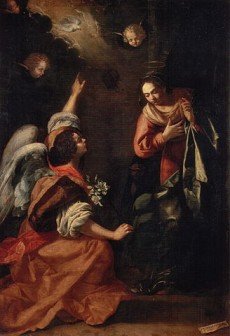
Artemisia arrived in Rome in 1621, with her daughters in tow. Some sources say that she left her husband in Florence, though others have him assaulting a group of “Spanish admirers” outside her villa in 1622. He may have followed her to try and effect a reconciliation, but if so it did not succeed. By the next year he was gone from her life permanently. This left Artemisia free to be, be the standards of the era, appropriately terrible. Her already ruined reputation left her free to pursue whatever relationships she desired, and rumours circulated wildly. Nothing provable survives however, and it’s certain that her main concern was providing for her children. She wasn’t above exploiting her reputation for gain however, and some art critics point to her work as catering to a niche market that desired more dominant female figures than mainstream art provided.
Artemisia loved Rome, but was unable to find enough there to support her family. She moved to Venice in 1627, and then to Naples in 1630. Here she found financial stability, though she was not fond of the city. She found it too violent, and even asked one of her patrons to help her get a license to carry a pistol. Still, she was popular and undoubtedly successful, and so she wound up spending most of the next twenty years in the city. Her daughters married local men, and she both produced paintings and worked on cathedrals in the city. She became friends with many artists, the most notable being Massimo Stanzione. He was a painter who had received multiple honours from the Pope, and became one of the leading painters in Naples in the 17th century. The two had very similar styles and even collaborated on several paintings, each absorbing elements of the other’s style.
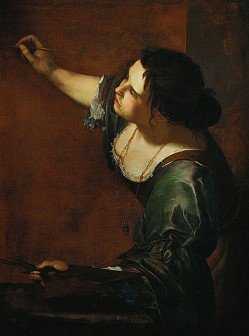
In 1638 Artemisia managed to get away from Naples for a few years and travelled to England. Here her father had become a court painter to King Charles I, who maintained a large number of artists. Father and daughter collaborated on painting a large ceiling in Malborough House in Greenwich (which at the time was the Queen’s private residence). One reason for this was her father’s failing health, and he died in 1639. Another reason, however, was that Charles asked her father to have her come to the court. He was curious to see the strong-willed woman painter who had made a name for herself in Europe, and she clearly did not disappoint. She stayed in England for three years (prudently leaving before the rebellion of 1642), and left behind her one of her most famous paintings, Self Portrait As The Allegory Of Painting. The iconographical handbook of the day described “Painting” as “a beautiful woman, with full black hair, dishevelled, and twisted in various ways, with arched eyebrows that show imaginative thought, the mouth covered with a cloth tied behind her ears, with a chain of gold at her throat from which hangs a mask.” Though Artemisia omitted the gag, the rest seems to have described her exactly. One can imagine she found no small amusement in making this a self-portrait.
Artemisia returned to Naples, where she spent the rest of her life painting. Her main patron (and occasional lover) was a Sicilian, Don Antonio Ruffio, notable as one of the few people outside the Netherlands to discover and appreciate the work of the great Rembrandt. The two corresponded frequently and most of their letters have survived, helping to give us an idea of Artemisia’s relaxed drift through her well-deserved success. Critics point to a “softening” of the female figures in her works around this time, though opinions are divided as to whether it reflects changing tastes or Artemisia’s changing character. Sometime around 1652 she died, though the exact details are unknown. Her talent for scandalising the city and her disregard for other’s opinion of her show in the cruel poems written about her after her death – one describes her as “Once bait for men’s hearts, now bait for worms”. Clearly even in her fifties, she was capable of provoking jealousy in her contemporaries.
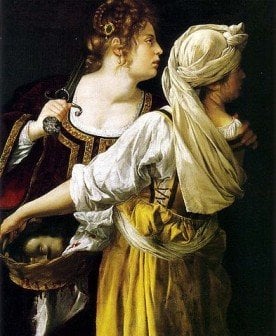
Artemisia was buried in Naples, but her tombstone was lost during a church renovation. An apt metaphor for her own fate, as later art critics soon tried to erase or ignore the existence of the woman who so blatantly contradicted their stereotypical vision of a renaissance painter. Her works were misattributed, even to the point of ignoring the signature, with most being assigned to her father or to Stanzione. Only in the twentieth century did she begin to get the recognition she deserved, when the Italian critic Robert Longhi wrote in 1916, on Judith Beheading Holofernes:
“It’s natural to say – this is a terrible woman! A woman painted all this?…There’s nothing sadistic here, instead what strikes the most is the impassibility of the painter…Incredible, I tell you!”
As society gradually matured in its opinion of female ability, art critics began to recognise Artemisia’s talent and identify the works that she had actually produced. Finally, in 1991, the first actual exhibition of Artemisia’s work was held. Even then, however, a few critics argued that some of her paintings “must be the work of Orazio”. [2] Few take such theories seriously however (mostly due to the marked dissimilarity from her father’s style, not to mention the fact that it’s her signature on the painting). Instead Artemisia has become an inspiration to modern artists, and the subject of several novels and at least one film. It seems that, as during her lifetime, Artemisia prevails.
Images via Wikimedia Commons.
[1] Some sources say two, some say four. Only the name of the eldest, Prudentia, survives. Sadly though it is known that she was trained in painting by her mother, none of her work is known.
[2] One reason quoted for this is the fact that the first version of “Judith Beheading Holofernes” seems to be painted with more assurance and skill than the follow-up – though personally I would be more inclined to attribute that to her having painted the first one before she had her thumbs brutally injured “for her own good” by a twisted legal system.
